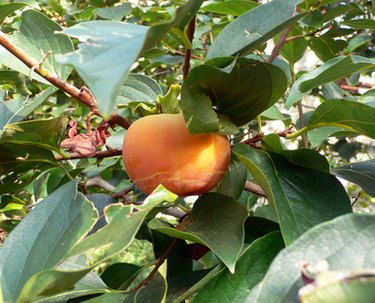
Only one tree can claim the lofty title of "food of the gods from Virginia." That, as expert forager Steve Brill reports, is the translation of the scientific name of the wild persimmon, Diospyrus virginiana. Fruit from the wild persimmon tree was used as food and medicine by the Native Americans. Early settlers in America soon learned that while unripe persimmons are all but inedible, the ripe fruit is a creamy combination of flavors that include plum, date and apricot.
Step 1
Search for wild persimmon trees in their native habitat along the East Coast as far north as New England, as far west as Kansas and in the south from Texas to Florida. Look for wild persimmon trees in sunny or partially sunny areas in forests, along the banks of streams and in bottomland swamps.
Video of the Day
Step 2
Check the bark of the tree for its unique structure. Foraging expert Steve Brill describes the bark as "thick, gray-black blocky squares about one-and-a-half inches across in a mosaic pattern."
Step 3
Inspect the leaves to see if they fit the description of wild persimmon tree leaves. They should be up to 6 inches long and 3 inches wide, dark green on the top and lighter green on the underside of the leaf. Wild persimmon leaves grow alternately (on two sides of a branch but not directly opposite one another), have an elliptical shape and are pointed at both ends.
Step 4
Look for bell-shaped, bright yellow flowers in the springtime, fruit that looks like a green cherry in late summer and ripe, deep-orange persimmons in late fall to mid-winter.
Step 5
Cut open the fruit of a tree you suspect to be a wild persimmon. The seeds of the wild persimmon are flat, brown and grow up to 1 1/2 inches long. There can be up to six seeds in one fruit.
Tip
Research the wild persimmon online or at your local library and become familiar with its distinctive features such as its bark and growing habits if you plan on foraging for wild persimmons. It is always advisable to consult with local experts before harvesting foods in the wild.
Warning
The fruit of an under-ripe persimmon is astringent and can be extrememly unpleasant to eat.
Never eat fruit from a wild tree that you have not positively identified.
Video of the Day